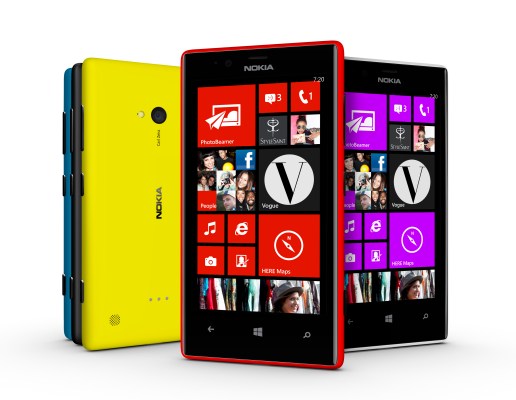Nokia has just reported is results for Q1 2013 with sales of $7.6 billion and a non-IFRS loss per share of $0.03 (and a reported EPS of $0.09) — a mixed result compared to analyst estimates, who had expected a loss per share of $0.05 on revenues of $8.65 billion (€6.6 billion). That estimated loss per share is effectively half of what it was a year ago, when Nokia posted a loss of $0.08 per share.
Nokia’s operating loss was $196 million, and while that’s down into the red again compared the previous quarter, when it posted an operating profit of $557 million, it’s a very significant improvement on a year ago, when its operating loss was $1.7 billion. Similarly, operating margin for the quarter was negative 1.5%, a reversal on the 6.8% of last quarter, but much better than the negative 5.1% of a year ago.
Analysts had also estimated that Nokia would report sales of 5.6 million Lumia devices for the quarter, and there Nokia was right on target, noting that the 5.6 million Lumias that it has sold are 27% on last quarter. The company has been building out the range of handsets it’s been selling in the last quarter, extending further into midrange and less expensive models. Nokia is estimating Lumia sales of 7.1 million for Q2, another rise of 27%.
“Nokia Lumia performance is promising considering this is the weakest quarter of the year and the new low end smartphones were not yet out,” noted Francisco Jeronimo, an analyst with IDC.
These are small but encouraging signs. To put these Lumia sales numbers in to context, a Reuters survey estimates that in the same quarter, Samsung has shipped 61.6 million smartphones, while Apple has shipped 36.9 million.
Here’s how Nokia’s results are breaking down for this quarter:
Devices. Not an overall great picture here. Device sales were $3.8 billion, down a full 25% compared to last quarter, and 32% compared to a year ago. Although Lumia sales trends are pointing in the right direction, they are still not big enough to offset Nokia’s other declines. The company’s feature phone business, which it terms simply “mobile phones”, were at 55.8 million units sold — down 30% on last quarter and 21% on a year ago. Within the smartphone segment, the last dregs of Symbian attrition also continue to give the company grief: Nokia sold 6.1 million smartphones in total, down 8% on last quarter, and 49% for the year.
Regions. Although mighty China, the world’s biggest smartphone market, used to be Nokia’s oyster, that time has long passed with the double juggernaut of Android and iOS taking away appetite for Nokia handsets. China saw the biggest drop of any region for Nokia in terms of sales by value and volume. The company reported $334 million in sales in Greater China, down 56% on a year ago, and putting it just above North America in terms of market size for the company. North America has been Nokia’s weakest market for some time already; China coming to join it in the bottom ranks is new. Of Nokia’s 61.9 million devices sold in the last quarter, only 3.4 million of those were in Greater China. Interestingly, North America was the only market in which Nokia saw a small increase in sales compared to last year — up by 9%, as some of its carrier deals to carry its smartphones continued to work their way through the balance sheet.
Here. CEO Stephen Elop announced in February that its mapping division would rebrand as “Here,” dropping the Nokia name, partly so that it could better target cross-platform business. Indeed, not only does it power Amazon’s location services, but Nokia’s maps are also available for Android and iOS, in addition to Windows Phone.
Whatever Nokia wants to call its mapping division, the unit continues to be the smallest division in the company. It reported sales of $281 million, a decline of 22% both on last year and last quarter, with the margin on services currently at nearly negative 45%.
NSN. What a lot of the decline in devices has meant for Nokia is that its infrastruture business is suddenly looking relatively okay. Whereas Nokia Siemens Networks used to only yield sales that were half as valuable as Nokia’s devices segment, these days they are more level with each other: NSN sales were $3.7 billion, while devices were at net sales of $3.8 billion. More importantly, NSN is posting a profit: $4 million. Yes, it’s small but again relative to the rest of Nokia’s balance sheet, this stands out. It’s also the only division with a positive margin, of 0.1%.
Some of these results were forecast by Nokia itself. In its Q4 2012 results Nokia posted better-than-expected results, with 4.4 million sales of its new Windows Phone Lumia smartphones and sales of $10.7 billion, but it also warned of a weaker Q1.
At the time, Nokia said it expected operating margin to be negative 2%, plus or minus four percentage points, citing “competitive industry dynamics” that have negative impact on smart devices and mobile phones. In other words, ever more competition from Apple and Samsung, which continue to keep a stronghold on smartphone sales, even as Windows Phone models, led by Nokia, are seeing gains. Indeed, Nokia noted that although Lumia smartphones continue to “ramp up” this may not offset larger consumer demand or the wider economic environment.
It also noted last quarter that it expected Location & Commerce non-IFRS operating margin in the first quarter 2013 to be negative “due to lower recognized revenue from internal sales, which carry higher gross margin, and to a lesser extent by a negative mix shift within external sales.”
We’ll be listening in on the call in just a while and will either update with more detail here, or post separately if the news merits it.
